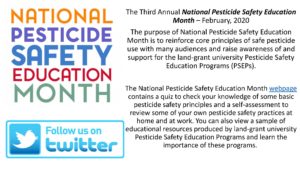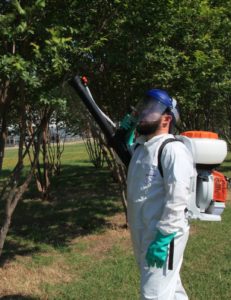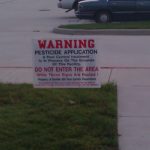 February is National Pesticide Safety Education month and I decided to devote this month’s newsletter to this topic.
February is National Pesticide Safety Education month and I decided to devote this month’s newsletter to this topic.
What is pesticide safety?
Safety is always an issue when using pesticides. Applicators, bystanders, and the environment can be harmed by exposure to pesticide concentrates or vapor drift. Those who work with pesticides must know and follow safe practices to reduce risk. Pesticide safety begins with choosing the correct product.
Safety is important in pesticide storage, transportation, mixing, and loading. Equipment cleanup and maintenance must be done safely. Unwanted pesticides and empty pesticide containers must be properly disposed.
How often do you the licensed applicator and/or the IPM Coordinator sit down and review the pesticide labels you use in your program? And do you follow up reading the label with reading the Safety Data Sheet (SDS)? Both documents contain a great deal of information not just on how to use the product, but also if that product could have any potential side effects to you the applicator.
Here are some key parts of the label you should focus your attention on.
Directions for Use. One of the most important sections of the pesticide label is the directions for use. This portion of the label is often one of the most lengthy and detailed. Do not assume that you remember the label from the last time you used the product. It is important to re-read the label each time you use the product. If you do not understand the directions on the label, do not use the product until you can get help from someone else familiar with interpreting labels, such as the product retailer, manufacturer, county extension agent, or state regulatory agency.
 Human Health Precautionary Statements. These statements must follow signal words and provide additional information about health precautions that should be taken when using the pesticide. Such statements might include information on which routes of entry are of special concern (e.g., mouth, eyes, lungs). In addition to route of entry, the label may list specific actions needed to prevent poisoning accidents. For example, the label may say: “Do not breathe vapors or spray mist,” “Do not get on skin or clothing,” or “Do not get in eyes.”
Human Health Precautionary Statements. These statements must follow signal words and provide additional information about health precautions that should be taken when using the pesticide. Such statements might include information on which routes of entry are of special concern (e.g., mouth, eyes, lungs). In addition to route of entry, the label may list specific actions needed to prevent poisoning accidents. For example, the label may say: “Do not breathe vapors or spray mist,” “Do not get on skin or clothing,” or “Do not get in eyes.”
Some labels fully describe the protective equipment you need, including the kind of respirator to wear. Other labels require the use of a respirator but do not specify type or model. Many labels carry no statement at all. You should follow all label instructions on protective clothing or equipment. However, a lack of instruction does not mean protection is unnecessary. Likewise, the mention of only one piece of equipment does not rule out the need for additional protection. As a minimum standard, always wear shoes, long-sleeved shirt and long pants when applying pesticides. Likewise, whether the label calls for it or not, it’s a good idea to wear chemical resistant gloves whenever mixing pesticides or working extensively with handheld pump sprayers.
Sensible selection of protective equipment depends on a thorough understanding of the pesticide, the job, the weather, the applicator and how these factors interact. For example, a WARNING label might state: “Causes skin and eye irritation. Do not get in eyes, on skin or on clothing. Wear goggles while handling.”
Safe pesticide use depends on risk awareness, proper protective equipment, skill at handling equipment and pesticides, plus careful personal hygiene and regular medical care.
Hazards to Wildlife and the Environment. Improperly applied pesticides may be harmful to the environment. Label statements pertaining to wildlife and the environment may include groundwater advisories or instructions on protection of endangered species. If a pesticide is hazardous to specific plants or animals, this fact will be noted in a special toxicity statement on the label. For example: “This product is highly toxic to bees,” “This product is toxic to fish” or “This product is toxic to birds and other wildlife.”
General Environmental Statements. These statements include common sense reminders to avoid environmental contamination, such as: “Do not apply where runoff is likely to occur,” “Do not allow drift on desirable plants or trees” or “Do not apply where the water table is close to the surface.”

Reentry statement. Some pesticide labels contain a reentry precaution. This tells you how much time must pass before people can reenter a treated area without protective clothing. Reentry intervals are set by the U.S. Environmental Protection Agency (EPA) when the review the pesticide product. Additionally, some states, like TX, have special reentry requirements for schools. Reentry intervals set by states are not always listed on the label. It is your job to find out if a reentry interval exists. If there is both a label reentry interval and a state reentry requirement, you must abide by whichever one is most restrictive. When no reentry interval is stated on a label, common sense dictates that no unprotected individuals should enter a treated area until dusts have settled or sprays have dried.
In TX on public school property, when using a Yellow Category product, the area must be posted at the time of application and remain posted at least 4 hours after the application is completed. At the same time, no students can be within 10 feet of the application site area. If you use a Red Category product, the area must be posted at the time of application and remain posted at least 8 hours after the application is completed. At the same time, no students can be within 25 feet of the application site area.
Protective Equipment and Personal Safety
Pesticides can enter your body through your skin, eyes, mouth and lungs. Pesticide poisoning occurs most commonly through skin contact. Some pesticides can soak through skin quite easily. Concentrates are especially dangerous. Also, two areas of your body, your head and genitalia, absorb pesticide very fast and need extra protection.
If a pesticide spills on you, your skin will absorb most of it within minutes. Wash off the pesticide immediately. Avoid direct contact with pesticides by wearing protective clothing. The pesticide label will tell you what protective equipment is necessary. When a label is silent (doesn’t provide clear instructions), at a minimum wear a long-sleeved shirt, long pants or coveralls, shoes and socks. It is also a good idea to wear chemical resistant gloves when you are mixing, loading and applying liquid pesticides to avoid contact with your hands. Remember what Dr. Renchie says about our hands, “they are the nastiest thing on our bodies” if you don’t protect yourself who will?
This information can be found in our School IPM Manual.
Merchant, Michael E., Don L. Renchie, and Janet Hurley. B-6015: An Introduction to IPM in Schools: A Manual for Facilities Maintenance Professionals. College Station, TX: AgriLife Extension, 2007.

 .
.